Arm Announces Mobile Armv9 CPU Microarchitectures: Cortex-X2, Cortex-A710 & Cortex-A510
by Andrei Frumusanu on May 25, 2021 9:00 AM EST- Posted in
- SoCs
- CPUs
- Arm
- Smartphones
- Mobile
- Cortex
- ARMv9
- Cortex-X2
- Cortex-A710
- Cortex-A510
A new CI-700 Coherent Interconnect & NI-700 NoC For SoCs
Finally, the last new announcement of the day is a new interconnect and network-on-chip generation. The last time Arm had announced a mobile/client interconnect was back in in 2015 with the CCI-550. The reason for the large gap between IPs, in Arm’s own words, is that ever since Arm’s introduction of the DSU in its CPU complexes, there really hasn’t been any need for a cache coherent interconnect in the market. While that’s eyebrow-raising from a GPU perspective, it makes perfect sense from a CPU perspective, as coherency between CPU cores was the primary driver for such interconnects until then.
With the advent of new more complex computing platforms, such as NPUs, accelerators, and hopeful more use of GPUs in cache-coherent fashions, Arm saw a need gap in its portfolio and decided to update its client-side interconnect IP.
The new CI-700 is a mobile and client optimised variant of Arm’s infrastructure CMN mesh network, implementing important new interoperability with the new IP announced today, such as the new DSU or CPU cores.
The new mesh interconnect scales up from 1 to 8 DSU clusters, and supports up to 8 memory controllers, and also introduces innovations such as a system level cache.
The mesh network topology and building blocks is very similar to what we’ve seen in the CMN infrastructure IP, in that “points” in the mesh are comprised of “cross-points” or “XP”. One differentiation that’s unique to the client mesh implementation is that XPs can have more attached connectivity ports, trading in routing connection paths. The new IP can also be configured as just a sole XP with no real mesh so to speak of, or essentially a 1x1 mesh configuration. This can grow up to a 4x3 mesh in the largest possible configuration.
The mesh supports from 1 to 8 SLC slices, with up to 4MB per slice for a total of 32MB, and snoop filter SRAM with coverage of up to 8MB address space per slice. It’s noted that generally Arm recommends 1.5-2x of coverage of the underlying private cache hierarchies of the mesh clients.
The SLC can server as both a bandwidth amplifier as well as reducing external memory/DRAM transactions, reducing system power reduction.
We see a reiteration of the support for MTE, allowing for this generation of IPs to support the feature across the new CPU IP, the DSU, and the new cache coherent interconnect.
Alongside the new CI-700 coherent interconnect, we’re also seeing a new NI-700 network-on-chip for non-coherent data transfers between a SoC’s various IP blocks. The big new improvements here is the introduction of packetization for data transfers, which leads to a reduction of wires and thus improves area efficiency of the NoC on the SoC.
Overall, the new system IP announced today is very interesting, but the one question that’s one has to ask oneself is exactly who these net interconnects are meant for. Over the last few years, we’ve seen essentially every major mobile vendor roll out their own in-house cache-coherent interconnect IP, such as Samsung’s SCI or MediaTek’s MCSI, and other times we don’t see vendors talk about their in-house interconnects at all (Qualcomm). Due to almost everybody having their own IP, I’m not sure what the likelihood would be that any of the big players would jump back to Arm’s own solutions – if somebody were to adopt it, it would rather be amongst the smaller name vendors and newcomers to the market. From a business and IP portfolio perspective, the new designs make a lot of sense and allows to have the building blocks to create a mostly Arm-only SoC, which is an important item to have on the menu for Arm’s more diverse customer base.


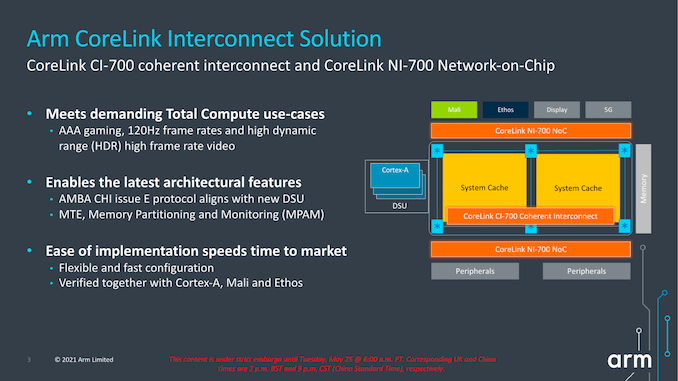

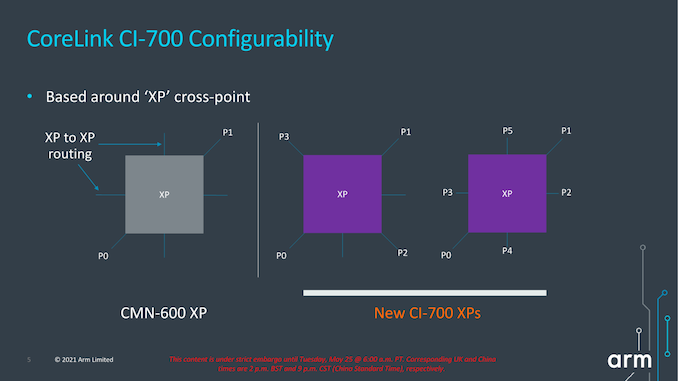
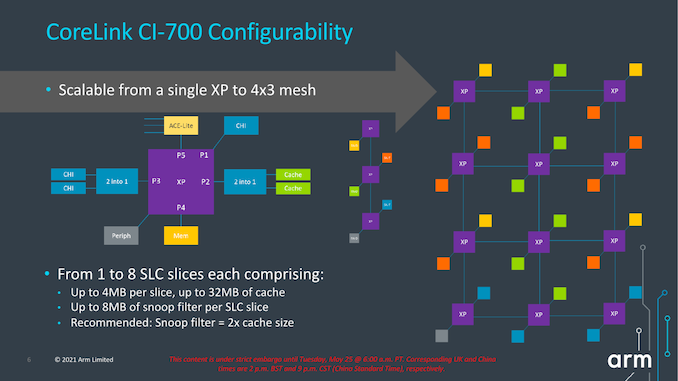
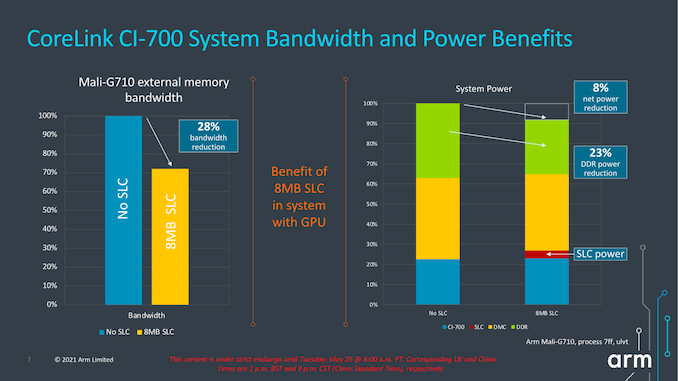
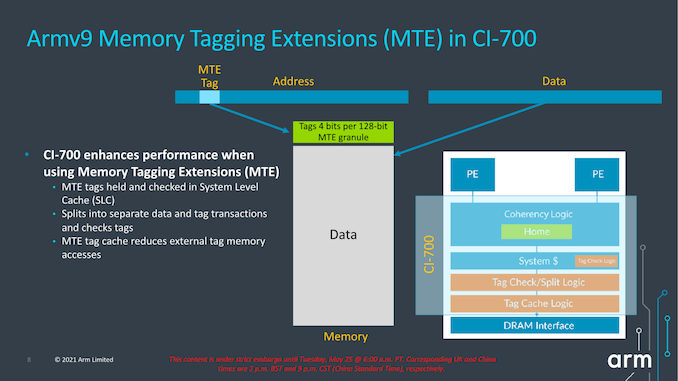









181 Comments
View All Comments
ChrisGX - Thursday, May 27, 2021 - link
Yes, @melgross, @mattbe and @mode_13h are absolutely right. Apple has an architectural license from ARM, viz. a license for the ARM ISA rather than any physical IP. Not deterred by that some individuals commenting here seem to want to suggest that Apple has infringed on ARM's IP or somehow by nefarious means has acquired crucial information about proprietary tech found in ARM chips without stumping up the cash for it. These suggestions are pathetic. If a patent infringement is being alleged please tell us the patent number so that we can determine for ourselves whether there really has been a patent infringement. Or, is a criminal conspiracy with other parties to steal trade secrets from ARM being asserted? There is an obvious problem with that idea. Does anyone seriously suppose that ARM would fail to have Apple before a court demanding a huge settlement for theft of trade secrets, if it had any reason to think that Apple had been engaged in such an exercise? Uninformed individuals are just making up things that chime with their sense of how things must be. Hmm...here's a thought. If you know so little about a topic that you wouldn't be willing to stake your reputation on it or swear to in a court, say, then perhaps saying nothing on the topic would be a better choice than pretending to possess knowledge that you so obviously don't possess.mode_13h - Saturday, May 29, 2021 - link
> Uninformed individuals are just making up things that chime with> their sense of how things must be.
Welcome to the world of internet comment forums.
> If you know so little about a topic that you wouldn't be willing to stake your reputation on it
We don't do "reputation". Everybody is on equal footing, here. Just challenge them with facts, references, and sound logic.
jeremyshaw - Tuesday, May 25, 2021 - link
Thanks SarahKerrigan, igor velky. I was mostly thinking of configurations we didn't commonly see. We have seen 4xLITTLE, 2xbig.4xLITTLE, etc even the 8xA78C. The slides on page 5 cover setups we have seen before. Mostly curious if the fabric is tied to specific configs like was implied at the 8xA78C launch, or if it's flexible enough to have, say, two X2, two A710, four A510, or something like one X2 with four A510 (like Intel's Lakefield), etc. IMO, there are a lot of embedded controllers that don't need a lot of CPU throughput, but can benefit from one faster core for UI.Kangal - Saturday, May 29, 2021 - link
I'm more interested in seeing a 3+5 design.The "Large Cores" just aren't good on a phone, a tablet maybe, not on a phone. We're already getting throttling on the "Medium Cores" (eg Cortex A78/A710). And most tasks on Android are handled great in Dualcore mode, and very few in Quad-core mode, when looking at the schedulers. So Three Medium Cores will offer 95% of the performance of your regular flagship processor. Extending the Small Cores to a group of five, also can help efficiency by having more performance in the lower zone, reducing the amount of times the large cores need to be stressed.
However, with what was announced today, we can actually expect a REDUCTION in 2022 ARM processors compared to 2021 ARM processors. I mean we're talking about 10% gains in X2, 10% gains in A710, and 1% gains in A510, when compared to a design that should be on a better node with better cache. That's not guaranteed with the continuing Chip Shortage. IN FACT most chipmakers are willing to "cheap out" and simply use the marketing of "running on ARMv9" to justify the higher cost and lower performance.
They stuffed up with the naming scheme btw. And they really stuffed up by not removing 32-bit support completely. And they stuffed up with not doing a blank-sheet approach, for a revolutionary ARMv9 design. We're going to see the smallest gains in Android Phones, just like it happened when people were comparing the QSD 800/801/805 to the QSD 808/810 (Cortex A57) back in 2015. Which hopefully means ARMs other divisions in UK/France can pick the slack and come with a proper successor. This would be the Cortex A72 to their Cortex A57, a la, 2022 A710 versus the 2023 A730. Though I doubt the little cores will get any improvement besides a 10% bump due to the node lithography improvements.
psychobriggsy - Monday, June 21, 2021 - link
Theoretically this should support 16 A510s (8 clusters), as each cluster shares a port on the interconnect.We may see 2X 4B 4L configurations (10 cores) one day, but in the main I guess we're stuck with 1X 3B 4L (8L?) options. I see budget chips using 4L+4L (wider FP on some).
Wonder if there's room for an A310 chip (4 int cores per cluster, 1 shared FP, 2-wide).
docola - Tuesday, May 25, 2021 - link
does the shift to 64 bit cpus and apps mean that todays phone will startbecoming obsolete starting next year?
iphonebestgamephone - Tuesday, May 25, 2021 - link
If you are on a 32 bit phone yeahdocola - Tuesday, May 25, 2021 - link
fun... so this means i shouldnt buy an expensive phone for another 1 or 2 years,because this is gonna be one of those rare REAL shift in tech... sigh....
supdawgwtfd - Tuesday, May 25, 2021 - link
Current phones support 64bit instructions...No need to delay.
docola - Tuesday, May 25, 2021 - link
great thanks! i know i sound ignorant in here oh well